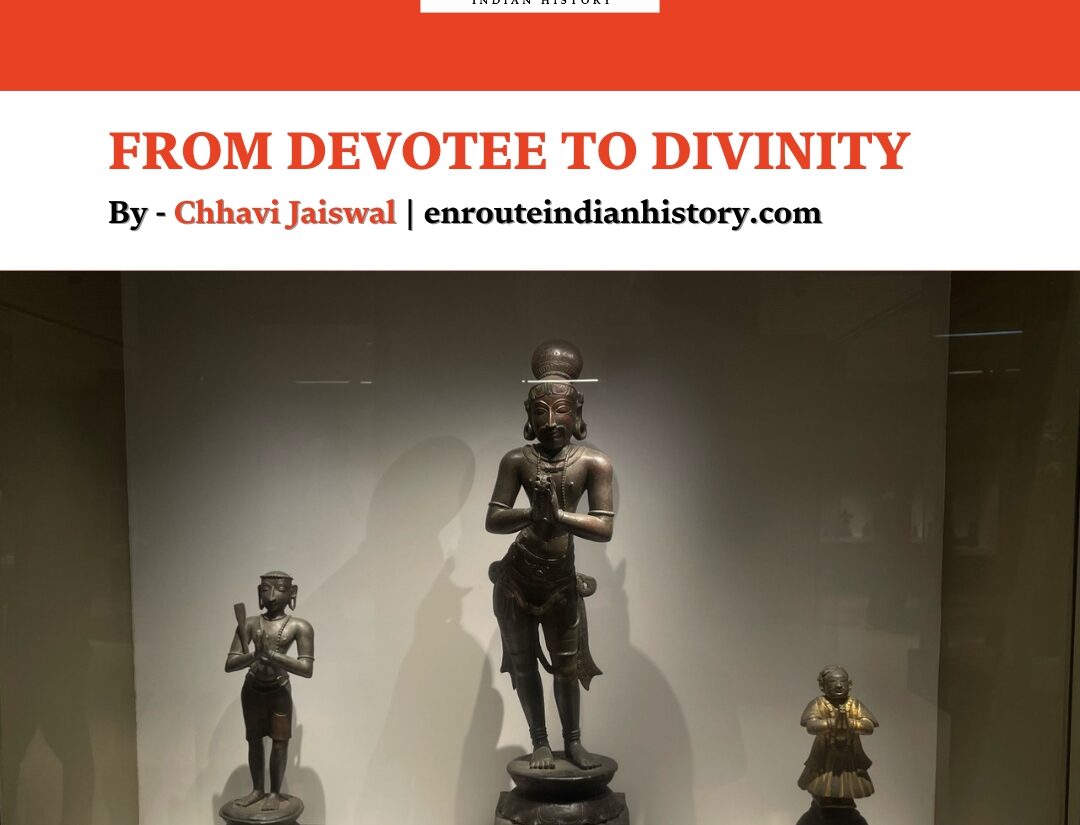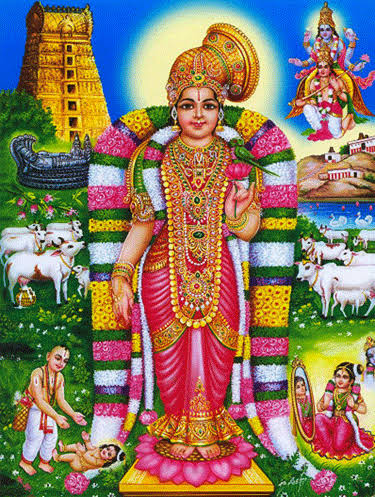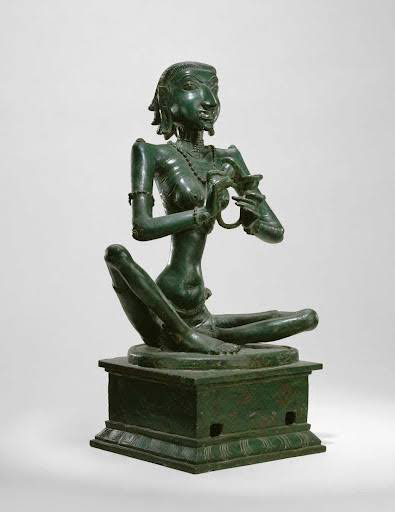
The Bhakti movement is one of the most profound spiritual revolutions in Indian history, where devotion transcended rituals, caste, and intellectual barriers. Rooted in the deep, personal worship of the Divine, this movement gave birth to numerous saints who experienced an all-consuming love for God. For these saints, devotion was an act of worship and a path toward oneness with the Divine. Their lives, marked by intense surrender and unwavering faith, ultimately led to a mystical union with the gods they adored. This article explores the lives of some of South India’s most revered Bhakti saints, whose devotion transcended all boundaries, and they eventually united with the divine.
The Bhakti movement began in the Tamil-speaking regions of South India in the 7th Century CE. It was marked by two sects, Alvars and Nayanars, who wrote highly devotional poetry for their respective revered deities, Vishnu and Shiva. There were 12 Alvar saints and 63 Nayanar saints who became venerated for their emotional poetry rich with emotional fervour. Some of these saints have legends associated with their names that reflect their journeys from a devotee or Bhakta to eventually becoming one with the divine.
Nammalvar was one of the most famous Bhakti poets and saints who became known for his poems and his contribution to Vaishnava theology. His works offer a unique blend of the principles of the Upanishads with the teachings of the Vedas, and he is often regarded as the kulpati or the founder-seer of the Vaishnava community. Hence, the epithet Nam-alvar (our Saint). He was born in the town of Alvarthirunagari in Tamil Nadu and was named Maran at birth. The legend follows that he was a yogi since the time of his birth. He was a prodigy and grew up differently than other children of his age. When his parents took him to a Vishnu temple, he sat under a tree and went into a meditative state for 16 years. Eventually, he was awakened from his trance by Madhurkavi, another Alvar saint, who sought him as his master. As a result, he burst into Tamil hymns of divine love known as Tiruvaymoli or divine utterances. According to tradition, at the end of Nammalvar’s life, Vishnu himself came to receive him to take him to his heavenly abode, Vaikuntha and Nammalvar finally attained moksha or spiritual liberation.

(An idol of Nammalvar; Source: Wikidata)
Another Alvar saint and one of the most prominent female Bhakti saints of India was Andal. She was born in Sri Villiputhur and was found in the flower garden of Alvar saint Periyalvar. In Vaishnava tradition, she is considered the incarnation of Vishnu’s consort, Bhu Devi. From her childhood, she developed an intense love for God and desired to marry Him. Her poetic corpus consists of two compositions: Tiruppavai, consisting of 30 hymns, and Nacciyar Tirupoli, made of 143 hymns. The Vaishnavas consider the Tiruppavai to be the “song of songs”.
According to tradition, when Andal came of age, the question of her marriage began to arise. It was then that Lord Ranganathan appeared to Periyalvar in a dream and asked him to bring her to Srirangam temple to offer her in marriage to Him. As commanded, Periyalavar took her to the temple, and as soon as she entered the Sanctum Sanctorum, she was absorbed into the idol. Her intimate relationship with God cannot be better expressed than in her own words, in which she writes:
“ Clouds that spill lovely pearls
what message has the dark-hued lord of Venkatam sent through you?
The fire of desire has invaded my body
I suffer.
I lie awake here in the thick of night,
a helpless target for the cool southern breeze.”

(Saint Andal; Source: Star Sai)
Sundarmurthi Nayanar was a devotee of Shiva. Born into a Brahmin family, Sundarar’s devotion to Lord Shiva was unique in its playful, personal relationship with the deity. He saw Shiva not as an abstract god but as a close friend and benefactor. According to tradition, Sundarar’s love for Shiva was so deep that, during his end, he prayed to Shiva to free him of his mortal form. Eventually, when he was mounting a white elephant to travel around a city he was visiting, Shiva designated time for him to leave his mortal form. As a result, the elephant rose and took him to Shiva’s abode, Mount Kailash where he eventually united with his God.
In the legends of divine love, the story of Karaikkal Ammaiyar stands out, who was also a Nayanar saint. A remarkable figure in the Bhakti movement, she was revered for her unwavering devotion to Lord Shiva. Born in Karaikal (modern-day Puducherry) around the 6th century CE, Ammaiyar, originally named Punitavati, was the wife of a wealthy merchant. Her devotion to Shiva began early in her life, but it was her extraordinary acts of selflessness that set her apart. Legend has it that she miraculously transformed a mango into a divine gift for her husband, which made him realise her otherworldly nature. Fearing her divinity, he abandoned her, leading her to renounce her worldly life. After this moment, she completely became engulfed in the Bhakti of Shiva. Her hymns celebrate Shiva not just as a creator but as a destroyer who embodies the cyclical nature of existence. For Ammaiyar, death was not the end but a gateway to Shiva’s eternal presence.
In her final moments, Ammaiyar was on a pilgrimage to Mount Kailash. Rather than walking upright like other pilgrims, she is said to have crawled on her hands, out of humility, towards her lord. Shiva, recognising her unmatched devotion, appeared before her and offered her a divine vision of his Tandava. She prayed for the boon of eternal service at his feet, and at that moment, she attained final liberation, becoming eternally united with Shiva.

(A sculpture of Karaikkal Ammaiyar; Source: Google Arts and Culture)
These legends tell us of the longing of the Bhakti saints to become one with God. The Bhakti movement prioritised the importance of bhakti as a form of sadhana( path or method) over the other two, namely, karma( work) or jnana( wisdom). This movement was primarily focused on attaining salvation through total surrender to God. It proved to be revolutionary in a way that it surpassed the distinctions of caste or gender and encompassed saints from all walks of life who advocated for the same goal, i.e. attainment of salvation through devotion.
In the later centuries, the Bhakti movement spread to parts of North India and Maharashtra, where many saints produced their works expressing their divine love through their poems. Poet-saints like Kabir or Meerabai challenged society through their works, focusing on a personal and more individualistic relationship with the Divine. In Maharashtra, the abhanga of poets like Tukaram dealt with social issues along with spirituality. The most notable aspect of the Bhakti movement was that it was the first of its kind, which addressed divinity in the language of the masses. This led to a democratisation of religion from the clasps of priestly authorities to the individual devotee.
Therefore, the Bhakti movement represents a profound spiritual awakening that transcended social, religious, and intellectual boundaries. The lives of saints like Nammalvar, Andal, Sundaramurthi Nayanar, and Karaikal Ammaiyar highlight the deep, personal connection they shared with the divine, leading them to ultimate union with their beloved gods. Their devotion, expressed through passionate poetry and heartfelt surrender, inspired millions and laid the foundation for a spiritual revolution that would reshape the religious landscape of India. By prioritising devotion over ritual, caste, or intellectualism, these saints paved the way for a more inclusive, accessible form of spirituality. The Bhakti movement’s emphasis on personal devotion and its rejection of societal distinctions continues to resonate across India, where the saints’ legacies live on in temples, festivals, and the hearts of devotees. These lines by the Nayanar saint Appar aptly summarise the spiritual aspirations of the movement,
“I searched for him and found him;
Tirum I and four-faced Ayan,
however much they searched
Looked all in vain
I searched for God and found in him
In my heart”
References:
- Chari, S.M.S. Philosophy and Theistic Mysticism of the Alvars. Delhi, Motilal Banarasidas Publishers, 1994, pp. 1-32.
- Nishanth, Divya. Legends of the Nayanmars. Tirumala Tirupati Devasthanams, 2014.
- Pathak, Radhika Mohan. “The Bhakti Movement: Transforming Medieval Indian Society.” International Journal of Arts Humanities and Social Sciences, vol. (2021), no.1, 2021, pp. 1-4.
- Srinivasan, Ramanathan, P.S. Aithal. “Bhakti Blossoms: Tamil Poetry’s Journey into Spiritual Depths, Unraveling Devotion and Cultural Significance.” International Journal of Philosophy and Language, vol.3, no.1, April 2024, pp. 23-35.
- Venkatesan. The Secret Garland: Andal’a Tiruppavai and Nacciyar Tirumoli. New Delhi, Harper Collins, 2016 https://archana.faculty.ucdavis.edu/translations/andal-nacciyar-tirumoli/
- Tirunāvukkaracar. The Garland of Limbs( Appar Tevaram 4.9). Long Poem Magazine, translated by Alastair McGlashan. https://longpoemmagazine.org.uk/issues/issue-four/the-garland-of-limbs


















